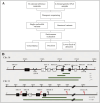Applying the National Genomic DNA Reference Materials to Evaluate the Performance of Nanopore Sequencing in Identifying Thalassemia Variants
- PMID: 40394932
- PMCID: PMC12144573
- DOI: 10.1002/jcla.70044
Applying the National Genomic DNA Reference Materials to Evaluate the Performance of Nanopore Sequencing in Identifying Thalassemia Variants
Abstract
Objectives: Nanopore sequencing shows advantages in detecting single nucleotide variations (SNVs), deletions, and complex structural variants as a single test in thalassemia. However, the performance evaluation or verification of this method remains unestablished, which is essential before clinical utility and panel registration. Here, we developed a classification method for thalassemia mutations, enabling automated interpretation, visual representation, and identification of diverse mutation types.
Methods: We used a total of 36 samples, comprising 32 reference materials and four clinical samples to assess the performance of nanopore sequencing in identifying variants in terms of concordance, precision, and the lower limits of detection.
Results: Our analysis successfully identified 19 SNVs, six deletions, and two triplications using nanopore sequencing across all samples. Notably, these variants showed complete concordance of 100% with the genotypes of the reference materials and known results. The precision of nanopore sequencing for detecting thalassemia variants was consistently high, with neither false positive nor false negative observed. Furthermore, the lower limits of detection achieved in our study were 3 ng/μL.
Conclusions: Overall, our study proved that the reference materials can be used to evaluate the performance of nanopore sequencing in identifying thalassemia mutations, and it is necessary to incorporate triplications when utilizing reference materials for performance evaluation of long-read sequencing. The consistent and robust performance of nanopore sequencing in this study demonstrates its potential as a reliable method for comprehensive variant detection in thalassemia and other genetic diseases diagnosis.
Keywords: Long read sequencing; nanopore sequencing; national reference material; thalassemia; variant.
© 2025 The Author(s). Journal of Clinical Laboratory Analysis published by Wiley Periodicals LLC.
Conflict of interest statement
The authors declare no conflicts of interest.
Figures



Similar articles
-
Investigating the Performance of Oxford Nanopore Long-Read Sequencing with Respect to Illumina Microarrays and Short-Read Sequencing.Int J Mol Sci. 2025 May 8;26(10):4492. doi: 10.3390/ijms26104492. Int J Mol Sci. 2025. PMID: 40429637 Free PMC article.
-
Implementation of Nanopore sequencing as a pragmatic workflow for copy number variant confirmation in the clinic.J Transl Med. 2023 Jun 10;21(1):378. doi: 10.1186/s12967-023-04243-y. J Transl Med. 2023. PMID: 37301971 Free PMC article.
-
Standardization of 16S rRNA gene sequencing using nanopore long read sequencing technology for clinical diagnosis of culture negative infections.Front Cell Infect Microbiol. 2025 Mar 6;15:1517208. doi: 10.3389/fcimb.2025.1517208. eCollection 2025. Front Cell Infect Microbiol. 2025. PMID: 40115075 Free PMC article.
-
Applications of Nanopore sequencing in precision cancer medicine.Int J Cancer. 2024 Dec 15;155(12):2129-2140. doi: 10.1002/ijc.35100. Epub 2024 Jul 19. Int J Cancer. 2024. PMID: 39031959 Review.
-
Solid-state nanopores towards single-molecule DNA sequencing.J Hum Genet. 2020 Jan;65(1):69-77. doi: 10.1038/s10038-019-0655-8. Epub 2019 Aug 16. J Hum Genet. 2020. PMID: 31420594 Review.
References
-
- Weatherall D. J. and Clegg J. B., “Thalassemia—A Global Public Health Problem,” Nature Medicine 2, no. 8 (1996): 847–849. - PubMed
MeSH terms
Grants and funding
LinkOut - more resources
Full Text Sources
Medical

